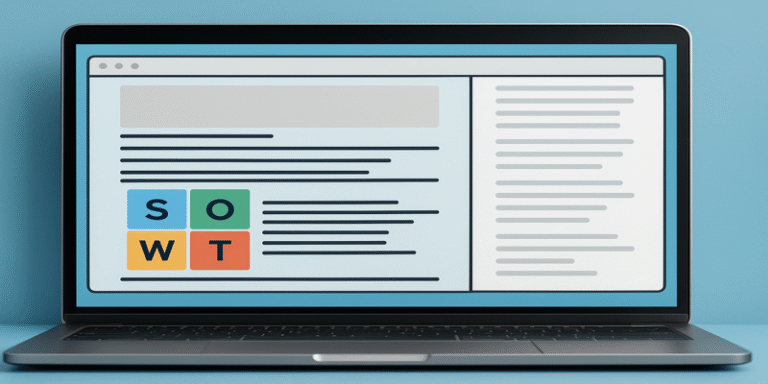In today’s fast-paced world, whether you’re a student, entrepreneur, nonprofit leader, or simply curious, one fundamental strategic tool you’ll encounter is SWOT Analysis. This deceptively simple framework can empower you to make better decisions by exploring internal and external factors. Let’s dive into what it is, why it’s so widely used, its origins, benefits and limitations—all illustrated with lively, real-world examples.
1.0 What Is SWOT Analysis?
SWOT stands for Strengths, Weaknesses, Opportunities, and Threats—four categories used to structure analysis of a situation. The tool helps in evaluating an organisation’s current position, whether it’s a company, a non-profit, a community project—or even an individual—by distinguishing internal factors you can control (strengths and weaknesses) from external elements you must navigate (opportunities and threats) (Teoli, 2023; Wikipedia, 2025a).
As a strategic planning tool, SWOT is often visualised as a simple 2×2 matrix, making it easy to summarise key points and foster discussion (Gürel & Tat, 2017).
2.0 Origins and Scholarly Roots
Although often attributed loosely to Albert Humphrey at Stanford in the 1960s, historical research shows the concept emerged collaboratively. In 1965 at Stanford’s Long Range Planning Service, Robert Stewart and colleagues developed the “SOFT” framework—standing for Satisfactory, Opportunities, Faults, Threats—which evolved into what we now know as SWOT (Wikipedia, 2025a).
Simultaneously, at Harvard Business School, Edmund P. Learned, C. Roland Christensen, Kenneth R. Andrews, and William D. Guth presented these four aspects (though not labelled SWOT) in their influential textbook Business Policy: Text and Cases, laying the foundation for widespread adoption (Puyt et al., 2024).
In recent historical work, Puyt et al. (2024) underscore the collaborative and evolutionary nature of SWOT’s development across several authors and contexts.
3.0 Why SWOT Remains Popular
3.1 Simplicity and Versatility
Anyone can grasp SWOT—with minimal jargon, it’s perfect for dynamic environments. Whether mapping an SME’s launch strategy or evaluating public service projects, SWOT sparks thoughtful dialogue (Gürel & Tat, 2017).
3.2 Great Everyone-Is-Included Tool
Typically, SWOT is performed in inclusive workshops or meetings, allowing input from people with different perspectives. This collective process enriches the analysis and builds ownership (West Virginia University, n.d.).
3.3 Adaptability Across Contexts
Not limited to business, SWOT has been used for non-profit planning, individual career mapping, public sector strategy, and more (Wikipedia, 2025a).
4.0 A Fresh Example: SWOT for an Indie Café
Imagine you’re opening a small café in London:
- Strengths: Your location is near a university, you’ve an Instagrammable interior, and you bake signature scones. These are internal assets you control.
- Weaknesses: You have limited staff, no delivery infrastructure, and a tiny marketing budget—these could hinder growth.
- Opportunities: A new cycle-path nearby brings foot traffic; partnering with local artists could host events; seasonal festive markets may boost awareness.
- Threats: Nearby chain cafés and rising rent costs loom large. These are external risks.
This SWOT helps you craft strategies—maybe hosting poetry evenings to attract students or negotiating landlord partnerships to manage costs.
5.0 Moving from Insight to Action
A common critique of SWOT is that it often ends as just a “list-making exercise” without follow-through. Hill & Westbrook (1997), for instance, observed that outputs are frequently unused in strategy execution (Wikipedia, 2025a).
To maximise value, organisations should:
- Prioritise: Not all factors are equal—select top 2–3 items per quadrant.
- Integrate analysis into a broader decision process, such as pairing SWOT with PEST (Political, Economic, Social, Technological) for richer context (Wikipedia, 2025b).
- Employ iterative review: As objectives shift, revisit and revise your SWOT (West Virginia University, n.d.).
6.0 SWOT in Action: Tech Adoption by SMEs
A 2014 academic study applied SWOT to understand cloud computing adoption by SMEs. This analysis highlighted:
- Strengths: Cost savings, scalability, flexibility.
- Weaknesses: Lack of expertise, security concerns.
- Opportunities: New markets, remote workforce enablement.
- Threats: Data breaches, unreliable internet infrastructure (Khajeh-Hosseini, Greenwood & Sommerville, 2014).
This real-world use of SWOT transformed abstract thought into actionable clarity for SMEs considering technological change.
7.0 Looking to the Future: Improving SWOT Usage
To evolve beyond simple listing, several modern enhancements are proposed:
- Extended SWOT models: Researchers have designed advanced variants that probe deeper into factors and stakeholder views (Puyt et al., 2024).
- Combining with other tools: Pairing SWOT with frameworks like Balanced Scorecards or TOWS enables follow-through from analysis to strategy execution (Gürel & Tat, 2017).
8.0 Summary Table: SWOT Snapshot
| Element | Description | Example (Café) |
| Strengths | Internal assets | University location, signature scones |
| Weaknesses | Internal limitations | Small team, limited marketing budget |
| Opportunities | External favourable factors | Cycle-path, seasonal markets |
| Threats | External risks | Competitor chains, rising rent |
But remember: meaningful strategy begins after you’re done with the matrix.
9.0 Final Thought: SWOT as a Starting Point
SWOT Analysis continues to hold appeal because it’s intuitive, flexible, and broadly applicable. Yet, using it wisely means pairing it with action: prioritisation, iteration, and integration into a wider strategic framework.
Whether you’re planning a café or charting a career shift, SWOT offers a clear lens—but it’s what you do with the view that truly matters.
References
Gürel, E. & Tat, M., 2017. SWOT Analysis: A Theoretical Review. The Journal of International Social Research, 10(51), pp. 994-1006.
Khajeh-Hosseini, A., Greenwood, D. & Sommerville, I., 2014. Towards Cloud Computing: A SWOT Analysis on its Adoption in SMEs. arXiv preprint arXiv:1405.1932.
Puyt, R.W., Lie, R., Benders, J., Grotenhuis, R. & Dijkstra, L., 2024. From SOFT Approach to SWOT Analysis, a Historical Reconstruction. Journal of Management History, 30(1), pp. 15-35.
Teoli, D., 2023. SWOT Analysis. In: StatPearls. Treasure Island (FL): StatPearls Publishing.
West Virginia University, n.d. SWOT Analysis Tool. Available at: https://talentandculture.wvu.edu/files/d/6ed4bddf-91fe-4f08-9904-c13b8b30cbe8/swot-analysis-tool.pdf [Accessed 14 Aug. 2025].
Wikipedia, 2025a. SWOT Analysis. Available at: https://en.wikipedia.org/wiki/SWOT_analysis [Accessed 14 Aug. 2025].
Wikipedia, 2025b. PEST Analysis. Available at: https://en.wikipedia.org/wiki/PEST_analysis [Accessed 14 Aug. 2025].









